ASA Issues Guidance on Statistical Statements for Forensic Evidence
In response to concerns that the use of forensic evidence such as shoe prints, fingerprints, bite marks, fibers, or hairs has contributed to wrongful convictions, the ASA has released a document with guidelines for discussing forensic evidence.
“Past errors provide us with opportunities to work with the forensic science community to improve the process and strengthen the use of forensic evidence,” said ASA president Karen Kafadar. “This statement is just one step in
that direction, but we hope it will be an important step."
In particular, the ASA wants experts to base their testimonies on databases and quantitative analyses, rather than subjective personal experiences.
 Getty images
Getty images
“The forensic practitioners are dedicated and well-meaning—they see agreement between a crime scene sample and one provided by a suspect and they’re trying to assess the relevance or value of that evidence for prosecuting the crime,”
said Hal Stern, vice-chair of the ASA Advisory Committee on Forensic Science. “One point of the ASA statement is that if you’re overstating or understating the value of the evidence, there are several harms that can occur. If you overstate
the evidence, you might put the wrong person in jail, but just as importantly, the guilty party would go free.”
The ASA statement extends a document drafted but not passed by the NCFS. The ASA Advisory Committee on Forensic Science,
under the leadership of Kafadar and Stern, updated that document with the latest statistical research.
"Ultimately, we hope this statement will be useful in explaining to stakeholders—forensic scientists, law enforcement officers, and courtroom personnel—the data necessary for making assessments about sources of evidence,” Kafadar said.
“We also hope the document will guide forensic scientists toward the type of research needed to strengthen and quantify the value of evidence being presented in criminal cases and thereby increase our confidence in the judicial system.”
The ASA statement encourages practitioners to follow “reliable and valid” scientific processes, audited by an independent science organization such as the National Institute of Standards and Technology, as the NCFS recommended.
For more information, see this press release.